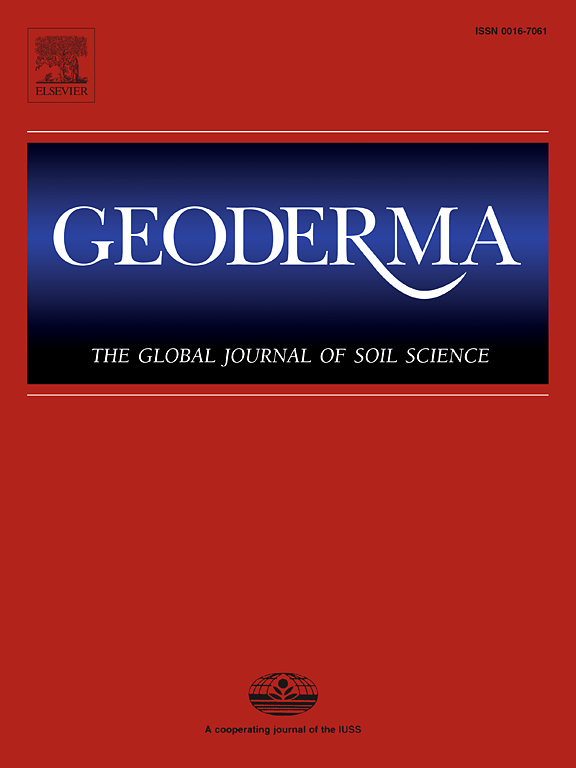利用燃烧分析同时测量土壤有机碳和无机碳
IF 5.6
1区 农林科学
Q1 SOIL SCIENCE
引用次数: 0
摘要
由于土壤有机碳 (SOC) 和土壤无机碳 (SIC) 与其他关键土壤性质的关系以及对土壤健康和碳储存的指示作用,它们长期以来一直备受关注。在 USDA-NRCS 凯洛格土壤调查实验室(KSSL),总碳量(SOC + SIC)是通过干燃烧分析确定的,而碳酸钙(CaCO3)当量则是通过人碳测量法确定的。对于石灰质(含碳酸盐)样本,SIC 按 CaCO3 当量的 12% 估算,而 SOC 则按测量的总碳量与估算的 SIC 之差估算。为了直接测量(而不是估算)钙质样本的无机碳和有机碳,我们评估了另一种测量 SOC 和 SIC 库的干燃烧方法。替代的温度斜坡干法(TRDC)包括两种变体,它们在斜坡周期和使用的载气方面有所不同。一种变体在持续氧气条件下运行,温度斜坡平台分别为 400、600 和 900 °C;因此被称为非气体切换变体或 TRDCNGS。另一个变体在氧气条件下运行至 400 ℃,然后切换到氮气,温度斜坡上升至 900 ℃,然后在 900 ℃ 时重新引入氧气;因此,它被称为气体切换变体或 TRDCGS。这两种变体都被一式两份地应用于 110 个不同的样品,其中包括 32 个钙质样品,这些样品来自美国各地,之前已被 KSSL 鉴定过。样本的选择是为了捕捉碳含量的巨大差异。将碳数据结果与 KSSL 传统方法的数据进行比较后发现,TRDCGS 变体最适用于钙质样本,而 TRDCNGS 变体则更适用于非钙质样本。将这两种方法变体结合起来,可以准确、直接地测量 SOC 和 SIC。对于钙质样本,中红外(MIR)光谱分析表明 TRDC 方法在估算 SOC 和 SIC 方面比传统的 KSSL 方法更准确。本文章由计算机程序翻译,如有差异,请以英文原文为准。
Using combustion analysis to simultaneously measure soil organic and inorganic carbon
Soil organic carbon (SOC) and soil inorganic carbon (SIC) are of longstanding interest due to their relationship with other key soil properties and indications for soil health and carbon storage. At the USDA-NRCS Kellogg Soil Survey Laboratory (KSSL), total carbon (SOC + SIC) is determined via dry combustion analysis, while calcium carbonate (CaCO3) equivalent is determined via manocalcimetry. For calcareous (carbonate bearing) samples, SIC is estimated as 12 % of CaCO3 equivalent, while SOC is estimated as the difference between measured total carbon and estimated SIC. An alternative dry combustion method for the measurement of SOC and SIC pools was evaluated with the goal of directly measuring – not estimating – inorganic and organic carbon on calcareous samples. The alternative temperature ramp dry combustion (TRDC) method comprises two variants that differ in ramp cycle and carrier gases used. One variant operates under continuous oxygen and has temperature ramp plateaus of 400, 600 and 900 °C; thus, it is referred to as the non-gas switching variant or TRDCNGS. The other variant operates under oxygen until 400 °C, then switches to nitrogen gas for a ramp to 900 °C, then reintroduces oxygen at 900 °C; thus, it is referred to as the gas switching variant or TRDCGS. Both variants were applied in duplicate to 110 diverse samples, including 32 calcareous samples, from across the USA that had been previously characterized by the KSSL. Samples were selected to capture wide variability in carbon contents. Comparing carbon data outcomes with data from the legacy KSSL methods revealed the TRDCGS variant as best for calcareous samples, whereas the TRDCNGS variant was preferred for non-calcareous samples. A combination of the two method variants offers an accurate and direct measurement of SOC and SIC. For calcareous samples, mid-infrared (MIR) spectral analysis demonstrated TRDC method as slightly more accurate than legacy KSSL methods for estimating SOC and SIC.
求助全文
通过发布文献求助,成功后即可免费获取论文全文。
去求助
来源期刊

Geoderma
农林科学-土壤科学
CiteScore
11.80
自引率
6.60%
发文量
597
审稿时长
58 days
期刊介绍:
Geoderma - the global journal of soil science - welcomes authors, readers and soil research from all parts of the world, encourages worldwide soil studies, and embraces all aspects of soil science and its associated pedagogy. The journal particularly welcomes interdisciplinary work focusing on dynamic soil processes and functions across space and time.
 求助内容:
求助内容: 应助结果提醒方式:
应助结果提醒方式:


